List of titles and honours of the Spanish Crown
The current Spanish constitution refers to the monarchy as "the Crown of Spain" and the constitutional title of the monarch is simply rey/reina de España: that is, "king/queen of Spain". However, the constitution allows for the use of other historic titles pertaining to the Spanish monarchy, without specifying them. A decree promulgated 6 November 1987 at the Council of Ministers regulates the titles further, and on that basis the monarch of Spain has a right to use ("may use") those other titles appertaining to the Crown. Contrary to some belief, the long titulary that contains the list of over 20 kingdoms is not in state use, nor is it used in Spanish diplomacy. In fact, it has never been in use in that form, as "Spain" was never a part of the list in pre-1837 era when the long list was officially used.[1]
Spain, mentioned differently in the titulary depending on which monarch was reigning, was for more than three centuries also symbolized by the long list that started "...of Castile, Leon, Aragon,..." - The following long titulary in the feudal style was the last used officially in 1836 by Isabella II of Spain (see the account of titulary in her article) before she became constitutional queen.
The first king to officially use a derivation of the name "Spain" as the realm in the titulary was Charles I of Spain, who used "Rex Hispaniarum et Indiarum"(i.e., King of the Spains and Indies). This title was often used after his title of "Holy Roman Emperor," as "Emperor" was considered a superior title to "King." During his brief and controversial occupancy of the throne Joseph Napoleon Bonaparte, brother of Emperor Napoleon, also used a similar title, King of the Spains and the Indies.
During the first restoration of the historic dynasty, it returned to the traditional format (...of Castile, Leon, Aragon,...) until 1837, when the short version "queen of the Spains" was taken into use by Isabella II. The singular Spain was first used by Amadeo — he was "by divine grace and will of nation, king of Spain." During the second restoration, King Alfonso XII started to use "constitutional king of Spain, by divine and constitutional grace".
With the third restoration of the royal house of Spain, still current as of June 2014, the monarch uses the simple title "king of Spain", without any divine, national or constitutional reference.
Juan Carlos, king until June 2014, did not use the title of Catholic Majesty and the other titles and honours, but did not relinquish them.[2]
Titles held by the King of Spain
Spanish monarchical Titles or Style are listed in order of degrees of sovereignty, nobility, and honor:[3]
Kingdoms
 King of Spain
King of Spain.svg.png) King of Castile
King of Castile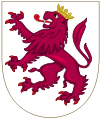 King of León
King of León King of Aragón
King of Aragón King of the Two Sicilies[fn 1]
King of the Two Sicilies[fn 1] King of Jerusalem[fn 1]
King of Jerusalem[fn 1] King of Cyprus[fn 1]
King of Cyprus[fn 1]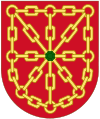 King of Navarre
King of Navarre King of Granada
King of Granada King of Mallorca
King of Mallorca King of Toledo
King of Toledo King of Seville
King of Seville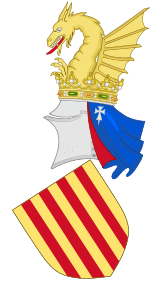 King of Valencia
King of Valencia%2C_16th_Century.svg.png) King of Galicia
King of Galicia King of Sardinia[fn 1]
King of Sardinia[fn 1].svg.png) King of Cordoba
King of Cordoba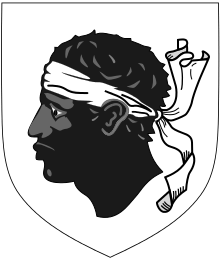 King of Corsica[fn 1]
King of Corsica[fn 1] King of Menorca
King of Menorca King of Murcia
King of Murcia King of Jaen
King of Jaen King of the Algarves[fn 1]
King of the Algarves[fn 1] King of Algeciras
King of Algeciras.svg.png) King of Gibraltar[fn 2]
King of Gibraltar[fn 2] King of the Canary Islands
King of the Canary Islands King of the Spanish East and West Indies and of the Islands and Mainland of the Ocean Sea[fn 1]
King of the Spanish East and West Indies and of the Islands and Mainland of the Ocean Sea[fn 1]
Archduchies
Duchies
.svg.png) Duke of Burgundy[fn 1]
Duke of Burgundy[fn 1] Duke of Brabant[fn 1]
Duke of Brabant[fn 1]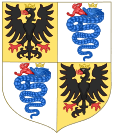 Duke of Milan[fn 1]
Duke of Milan[fn 1] Duke of Athens[fn 1]
Duke of Athens[fn 1]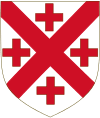 Duke of Neopatria[fn 1]
Duke of Neopatria[fn 1] Duke of Limburg[fn 1]
Duke of Limburg[fn 1]
Counties
 Count of Habsburg[fn 1]
Count of Habsburg[fn 1] Count of Flanders[fn 1]
Count of Flanders[fn 1] Count of Tyrol[fn 1]
Count of Tyrol[fn 1] Count of Roussillon[fn 1]
Count of Roussillon[fn 1] Count of Cerdanya
Count of Cerdanya Count of Barcelona
Count of Barcelona Count of Girona
Count of Girona Count of Osona
Count of Osona Count of Besalú
Count of Besalú Count of Covadonga
Count of Covadonga
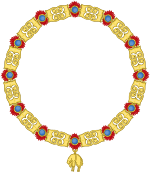
Lordships
Other titles maintained, but usually abbreviated with "etc."*
Because of the large amount of titles associated with the Spanish Crown, only the most important were written, finishing the list with "etc." or "&c.", referring to minor or obsolete titles. These titles are:
- King of Hungary, of Dalmatia, and of Croatia;
- Duke of Limburg, of Lorraine, of Luxembourg, of Gelderland, of Styria, of Carniola, of Carinthia, and of Württemberg;
- Landgrave of Alsace;
- Prince of Swabia;
- Palatine Count of Burgundy;
- Count of Artois, of Heinaut, of Namur, of Gorizia, of Haut-Rhin, and of Kyburg;
- Marquis of Oristano, and of Goceano;
- Margrave of the Holy Roman Empire, and of Burgau;
- Lord of Salins, of Mechelen, of the Slovenian March, of Pordenone, and of Tripoli.
Military rank
 Captain General (military rank reserved to the reigning monarch since 1999) (Commander-in-Chief) of the Royal Spanish Armed Forces and their Supreme Commander
Captain General (military rank reserved to the reigning monarch since 1999) (Commander-in-Chief) of the Royal Spanish Armed Forces and their Supreme Commander
Hereditary Orders of Spain

- Sovereign Grand Master of the Celebrated Order of the Golden Fleece
- Grand Master of the Royal & Distinguished Order of Charles III
- Grand Master of the Royal Order of Isabel, the Catholic
- Grand Master of the Royal and Military Order of Saint Ferdinand
- Grand Master of the Royal and Military Order of Saint Hermenegild
- Grand Master of the Order of Montesa
- Grand Master of the Order of Alcántara
- Grand Master of the Order of Calatrava
- Grand Master of the Order of Santiago
- Grand Master of the Order of Queen Maria Luisa
Titles of the heir apparent or heir presumptive

Titles and styles are listed in order of degrees of rank, nobility, and honor:[6]
Principalities
 Prince of Asturias — title of the first-in-line to the Kingdom of Spain and earlier Crown of Castile-León
Prince of Asturias — title of the first-in-line to the Kingdom of Spain and earlier Crown of Castile-León Prince of Girona — title of the first-in-line of the Crown of Aragon
Prince of Girona — title of the first-in-line of the Crown of Aragon Prince of Viana — title of the first-in-line of the Kingdom of Navarre
Prince of Viana — title of the first-in-line of the Kingdom of Navarre
Duchies, counties and lordships
.svg.png) Duke of Montblanc — title of the first-in-line to the Principality of Catalonia
Duke of Montblanc — title of the first-in-line to the Principality of Catalonia Count of Cervera — title of the first-in-line to the Kingdom of Valencia
Count of Cervera — title of the first-in-line to the Kingdom of Valencia Lord of Balaguer — title of the first-in-line to the Kingdom of Mallorca
Lord of Balaguer — title of the first-in-line to the Kingdom of Mallorca
Orders of the heir apparent
The following orders are traditionally granted to the heir apparent:
- Knight of the Celebrated Order of the Golden Fleece
- Knight of the Collar of the Royal & Distinguished Order of Charles III
- Knight Grand Cross of the Royal and Military Order of San Hermenegildo
- Commandeur-Major of Castile of the Order of Santiago
- Knight of the Order of Alcántara
- Knight of the Order of Calatrava
- Knight of the Order of Montesa
Royal titles
Duchies
- Cádiz
- Seville
- Segovia
- Badajoz
- Soria
- Lugo
- Palma de Mallorca
Counties
- Chinchón
- Molina
- Montemolín
- Montizón
- Barcelona
- Covadonga
Byzantine Empire
 The last titular Eastern Roman Emperor, Andreas Palaiologos, sold his imperial title to Ferdinand II of Aragon and Isabella I of Castile before his death in 1502.[7]
The last titular Eastern Roman Emperor, Andreas Palaiologos, sold his imperial title to Ferdinand II of Aragon and Isabella I of Castile before his death in 1502.[7]
However, in practice this title and claim was never much pushed or enacted to reclaim Constantinople or any Roman territories. Nevertheless, many cities and institutions in Spain to this day use the double headed Roman eagle. The city of Toledo, Spain and the province of Zamora, Spain are just few of many examples: see Coat of arms of Toledo (Spain).
See also
- Imperator totius Hispaniae
- Spanish monarchy
- List of titles and honours of Juan Carlos I of Spain
- List of titles and honours of Queen Sofía of Spain
- List of titles and honours of Felipe VI of Spain
- List of titles and honours of Queen Letizia of Spain
- List of titles and honours of Leonor, Princess of Asturias
Notes
- 1 2 3 4 5 6 7 8 9 10 11 12 13 14 15 16 17 18 Titles in Pretence: historical title which is only nominal and ceremonial.
- ↑ Since 2010 the Government of Gibraltar has referred to Elizabeth II as Queen of Gibraltar.[4] Initially just on coinage the title now appears on many government documents referencing the Queen.[5]
References
- ↑ (Spanish) Article 57 of the Spanish Constitution
- ↑ Almanach de Gotha 1999, Page 336, Decree of 1987
- ↑ (Spanish) Spanish Monarchy - theories, symbols and ceremonies, 20 June 2014, Once I Was A Clever Boy
- ↑ "No. 103/2010" (PDF) (Press release). Gibraltar: Government of Gibraltar. 2010-05-06. Retrieved 2016-04-18.
- ↑ "United Kingdom Partnership Agreement" (PDF). www.gov.uk. HM Government. 2014-10-15. Retrieved 2016-04-18.
The Governor of Gibraltar is the representative of the Queen of Gibraltar, Queen Elizabeth II.
- ↑ Casa de Su Majestad el Rey de España - La Monarquía en la Historia - The Monarchy through History
- ↑ Norwich, John Julius, Byzantium — The Decline and Fall, p. 446.

.svg.png)